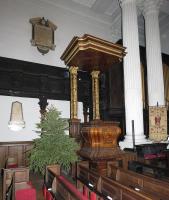
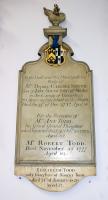
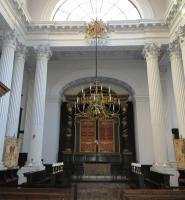
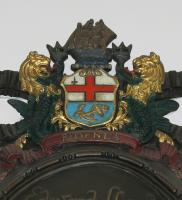
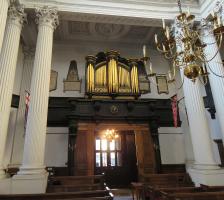
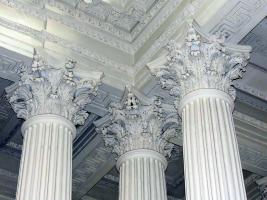
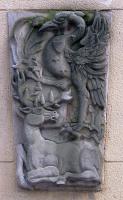
St Mary Woolnoth, on the corner of King William Street and Lombard Street, by the Bank of England, has one of the most distinctive exteriors of all the City Churches. Inside, it has an atmospheric interior, and a modest collection of memorials dating mostly from the late 18th and early 19th Century.
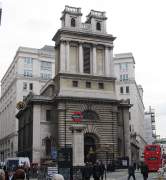
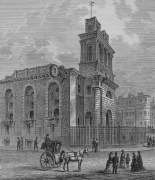 Two views of Hawksmoor's St Mary Woolnoth.
Two views of Hawksmoor's St Mary Woolnoth.
The site has a long history, the first church being built where a pottery and an ancient temple had once stood: so much pottery was found that in less enlightened times it was taken away to mend roads in Southwark. An early 15th century church was damaged in the Great Fire enough that it required a rebuilt by Sir Christopher Wren, but afterwards became dilapidated, and was rebuilt by Nicholas Hawksmoor, previously Wren’s assistant, with details by James Gibbs, another notable architect, and was completed in the 1720s (some sources say 1719).
Until the dissolution of the monasteries, the right of presentation belonged to the Convent of St Helen Bishopsgate (still extant as part of St Helen Bishopsgate, with many beautiful monuments), and afterwards passed to the Goldsmiths Company. There are different ideas about where the name came from, including that it derived from some nearby wool-weighing station, and that it was founded by a Saxon, Wulfnoth, on the site of an ancient temple. Perhaps it was this that led Hawksmoor to model the interior on a Roman atrium.
But first the outside. The site is where King William Street meets Lombard Street, which Hawksmoor took advantage by angling the frontage to the former, giving a better front view than is the case for many City Churches. In front of the rather squarish nave is a wide but not deep frontage, rising to two short towers, making the church somehow give the impression of some squat, miniature cathedral. An excellent thing.
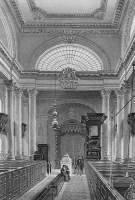 Interior, 1840s; the pulpit has since been moved to the left hand side.
Interior, 1840s; the pulpit has since been moved to the left hand side.
The interior is almost square in plan, and seems to have rested unchanged from the 1870s when William Butterfield in gave it a makeover, removing the galleries. At each corner are a group of three great Corinthian columns, with matching pilasters on the walls, which have dark wood panelling with minor ornament. The mouldings to the ceiling too are panelled with various ornaments, including winged cherub heads and foliage, and there is a great coat of arms with lion and unicorn, three larger sculpted winged cherub heads below, set under one of the semicircular windows. The altarpiece is a strange, solid thing, dark wood with red panels and gilded detail, two twisted pillars, heavy, three cherubic heads above the panel in shaped pedimental position, seven more cherubic heads on entablature above, resting on the pillars. The whole in a recess under an arch, and rather effective and entirely in keeping with the mood of the church.
The monuments, then:
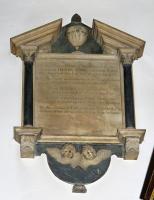 Simpson of Upper Thames Street's panel to Henry Fourdrinier, d.1799.
Simpson of Upper Thames Street's panel to Henry Fourdrinier, d.1799.
Sculpture of a mourning girl, to Revd. William Gunn, d.1806. 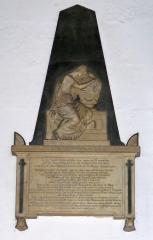
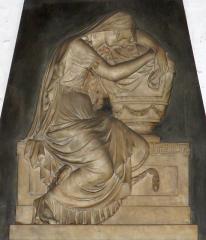
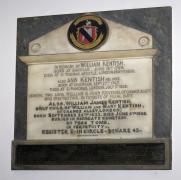 Stone mason Burston of New Road: panel to William Kentish, d.1830.
Stone mason Burston of New Road: panel to William Kentish, d.1830.
 Edward Lloyd, 1930s panel to founder of 'Lloyds of London'.
Edward Lloyd, 1930s panel to founder of 'Lloyds of London'.
We note that adjacent to the church on King William Street, and abutted against it, is the former entrance of Bank Station, designed by the City architect Sidney R.J. Smith, a low construction of five bays, making a rather nice ensemble with blocked windows behind, and bearing two large sculpted figures in high relief: they are Electricity and Speed, by Oliver Wheatley, a sculptor of some minor prominence in the art nouveau era.
Oliver Wheatley's sculptures Electricty and Speed for Bank Underground Station. 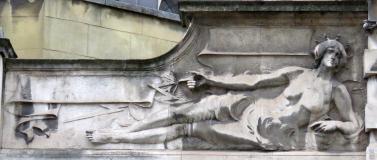
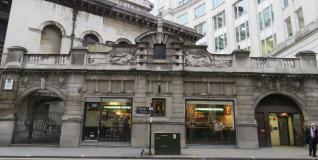
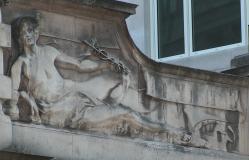
We can explore further, behind St Mary Woolnoth, thus between King William Street and Lombard Street, in Post Office Court. That is where the General Post Office had stood from the 1630s to the 1820s. Here on a wall are half a dozen obscure bits of sculpture: they apparently come from a later building on the site, but that was put up in at the end of the 1930s, and at least one of the plaques commemorates the General Post Office with the dates 1630-1951. Despite the VR monogram on a couple of the plaques, 1951 looks right for the set - conceivably associated with the 1951 World Fair? Along with the GPO plaque with carved oak leaves and acorns, we see a phoenix rising from the flames, a crane and stag in the style favoured by H.W. Palliser, heraldic shields, doves with a shield, and a ship.
With many thanks to the Church authorities for permission to show pictures from inside St Mary Woolnoth; their site is at http://stml.org.uk/about/
Post Office Court sculpture, ca. 1951. 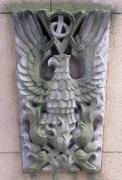
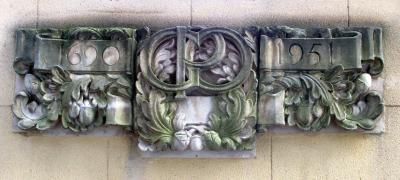
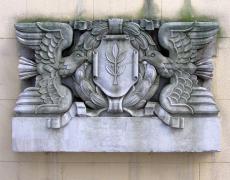
Just west to St Stephen Walbrook // West along Cheapside to St Mary le Bow // North and East along Cornhill // East along Fenchurch Street to St Gabriel's churchyard
City Churches // London sculpture // Sculptors // Introduction to church monuments
Angel statues // Cherub sculpture
Visits to this page from 19 Feb 2012: 10,755